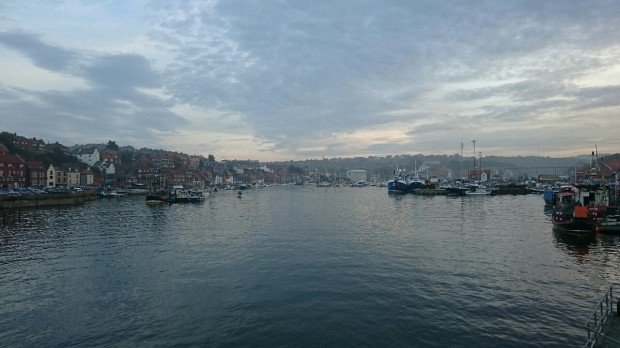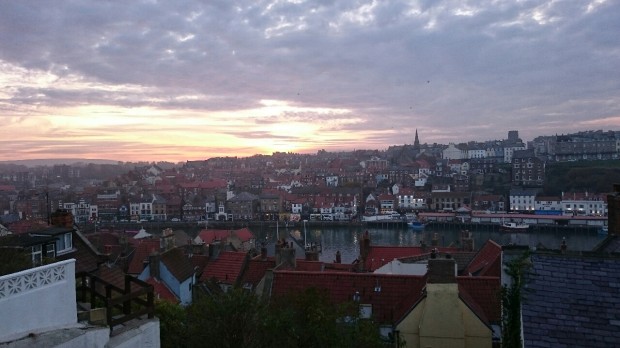There is a place that has been calling to me for many years now, since I first read Robin Jarvis’ eerie children’s classic The Whitby Witches, to the hours I spent immersed in Nicola Griffith’s Hild, the exquisite scenes at the heart of A.S. Byatt’s Possession, and of course, the arrival of Stoker’s Dracula. It has existed on the edge of my imagination as a place of stone serpents, Anglo Saxon poets, jet mermaids and pock-marked gravestones, and I knew that the first trip I had to make from my new home in York, was to the coast, where the black cliffs crumble into the North Sea, that is, to Whitby.
I decided there could be no better day for this than Halloween, and so booked a room at Arundel House from which I could see the silhouette of Whitby Abbey and the outline of St Mary’s Church across the harbour. Literary fame aside, Whitby is a picturesque little harbour town, with a pleasant promenade and pier lined, in typical seaside-resort fashion, with fish and chip shops, amusement arcades, icecream sellers and the pungent odor of freshly caught seafood. I was delighted by the stacked heaps of lobster pots, the sight of one or two fishing boats still working beyond the harbour and Church street, which winds up to the 199 steps and is crowded with stores selling jet, Gothic clothing and postcards. The independent Whitby Bookshop has a selection of small press books on local history and Yorkshire folklore.

In The Whitby Witches, the children visit the museum, which is one of those brilliantly preserved, local institutions that combines natural history (of which Whitby has much to boast) with the maritime, archaeological and regional crafts, keeping the 19th century classification and labels. The museum still has the hand of glory, which features in Witches, but I was even more fascinated by George Merryweather’s ‘Tempest Prognosticator’, an apparatus containing 12 pint glass bottles, each home to a medicinal leech and resembling a steampunk merry-go-round. It was shown at the Great Exhibition of 1851, with the accompanying statement that a leech, governed by it’s instinct, could predict oncoming storms and, through the telegraph, ring St Paul’s bell in London. The museum also has a fine collection of narwhal horns.
Due to a coincidence of timing, it being the first day after the end of daylight savings and the last day of English Heritage’s summer season, I arrived at the abbey just as the sun was setting. The ruins were virtually empty, just a few stray goths and a mouse darting about in the shadows. I ignored the audio tour and informative signage and walked, watching my own shadow moving along the walls and finding it easy to slip into imagining Saint Hilda and Caedmon and, much later, Victorian visitors getting a wonderful sense of the ‘gothic’ and ‘sublime’ of the place. On leaving the abbey I entered St Mary’s churchyard where I was met by, of all things, a large black dog. His name was Gordon and he was out for his evening walk.
The following morning I went down to the east cliff at low tide, the home of Jarvis’ ‘Aufwaders’ and the crumbling Jurassic cliffs where fossil hunters still pull dinosaur bones and ammonites from the stone. I combed the sands for jet and kept a wary eye on the tides which come in fast and all the way up to the cliffs, trapping the incautious. I have no doubt Whitby will continue to inspire fiction and poetry, it has that combination of beauty and danger, natural and human history which make it a mine of inspiration.

(all images are my own)
